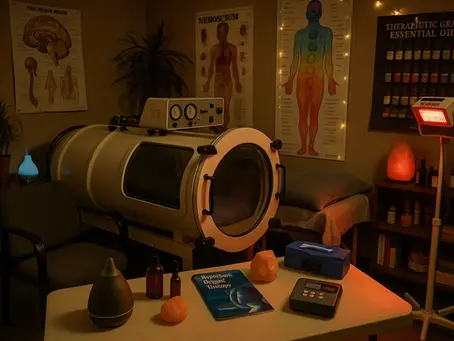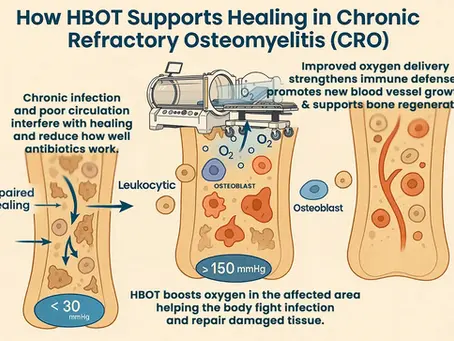top of page
Blog: Blog2

Shared Health Services Blog
Welcome to the Shared Health Services blog—a resource designed for hospitals and physician practices exploring outpatient wound care and hyperbaric medicine. We provide a proven framework, clinical expertise, and personalized support to help you launch and manage successful, branded programs that reflect your identity and meet your community’s needs.
Search


Superskin? What Wound Care Teams Need to Know About the New “Self-Healing” Hydrogel
A breakthrough in wound care is here: researchers at Aalto University in Finland and the University of Bayreuth in Germany have developed a self-healing hydrogel, nicknamed “Superskin.” This innovation could transform how clinicians approach complex wounds, combining coding-driven material design with lab-tested performance. Here’s what wound care teams need to know about its potential and clinical implications.
Aug 184 min read


Compliant Documentation Is Storytelling — Here’s Why It Matters
Great documentation is more than compliance — it’s storytelling. In wound care and hyperbaric oxygen therapy (HBOT), every patient record should read like a clear, defensible narrative. From proving HBOT candidacy to building treatment plans and tracking outcomes, each act in the story builds trust, supports reimbursement, and captures the real work happening in the treatment room.
Aug 1512 min read


From Pressure to Possibility: What 2025 Drug and Policy Shifts Mean for Wound Care Programs
From pricing reform and rebate pilots to direct-to-patient drug access and rural funding, hospitals are facing rapid shifts in how cellular and/or tissue-based products (CTPs) are purchased, reimbursed, and documented. This post breaks down what wound care leaders need to know — and how Shared Health Services helps partners respond with insight, compliance support, and tools that strengthen long-term strategies.
Aug 67 min read


Hyperbaric Oxygen Therapy Safety: Why Oversight Matters
In 2025, two tragic HBOT incidents at wellness clinics reignited concern across the field. This post explores the risks of non-clinical hyperbaric use, highlights what truly makes HBOT safe, and outlines the standards SHS champions for hospital- and physician-practice-based programs. If your team is re-evaluating protocols, credentials, or training, this is a must-read guide to safety, clarity, and clinical oversight.
Jul 184 min read


CMS Proposes Major Reimbursement Shifts for Skin Substitutes and Outpatient Services in 2026
CMS’s proposed 2026 OPPS rule could significantly impact wound care reimbursement, including major shifts for skin substitutes and outpatient services. This post breaks down what’s changing, what’s uncertain, and how Shared Health Services equips hospital leaders to stay ahead. Get clear insights and strategic takeaways to help your team prepare now.
Jul 175 min read


The Skin Subs Crackdown: Federal Indictments and the Future of CTP Reimbursement
The DOJ just indicted providers in one of the largest skin sub fraud schemes ever—and CMS is launching a new prior auth model targeting wound care. If your program uses cellular and/or tissue-based products (CTPs), now is the time to tighten documentation and revisit patient selection protocols. This blog breaks down what’s changing—and how SHS helps wound centers deliver compliant, audit-ready care.
Jul 23 min read


Wound Care Terminology Explained: CTPs, HCT/Ps, CAMPs, and Skin Substitutes
Wound care terminology is often inconsistent across clinical, academic, and regulatory settings. This post breaks down common terms like CTPs, HCT/Ps, and CAMPs—clarifying what they mean, who uses them, and where each appears in coverage policies, product literature, and documentation. Whether you're a clinician or hospital leader, this quick guide cuts through the confusion.
Mar 273 min read


Evidence-Based Advanced Wound Care Clinic Coming to Brookfield, Wisconsin
SAAK Health is launching a new evidence-based wound care clinic in Brookfield, WI — bringing advanced treatments and personalized support closer to home. This specialty clinic is designed to serve patients with chronic, non-healing wounds and support local providers through referral coordination and continuity of care.
Aug 21, 20242 min read


How Doxycycline Supports Healing in Chronic Wound Care
Doxycycline offers more than antibacterial effects—it may modulate chronic inflammation by targeting key molecular pathways. This post explores how doxycycline reduces MMP activity, TNF-alpha conversion, and nitric oxide production to support healing in complex, non-healing wounds.
Oct 23, 20203 min read


Chronic Osteomyelitis: How Hyperbaric Oxygen Therapy Supports Healing
Chronic refractory osteomyelitis is an infection that limits oxygen delivery and impairs healing. HBOT raises tissue oxygen levels to boost immune response, improve antibiotic access, and promote bone regeneration. This post explains how HBOT supports recovery when standard treatments fall short.
Oct 22, 20203 min read


Exploring Available Evidence for Hyperbaric Oxygen Therapy in Acute Traumatic Sports Injury
Hyperbaric oxygen therapy (HBOT) is being explored in sports medicine for soft tissue injuries like sprains, strains, and contusions. This post reviews the current research on HBOT for acute traumatic injuries and highlights its potential to reduce inflammation and support healing. We also honor athletes like Tristian—whose story reminds us why timely recovery matters in wound care and rehab.
Oct 19, 20205 min read


Understanding Oxygen Toxicity in Hyperbaric Medicine
Oxygen toxicity is a known risk during HBOT, but strategies like air breaks, antioxidant support, and oxygen scheduling can reduce that risk. This post explores the underlying mechanisms of cellular toxicity, the body’s natural defenses, and how hyperbaric teams can implement practical safety protocols to protect patients and optimize treatment outcomes.
Sep 15, 20203 min read


Are Dialysis Patients at Higher Risk During Hyperbaric Oxygen Therapy (HBOT)?
Dialysis patients face significantly higher cardiac risks during HBOT due to structural heart disease, electrolyte imbalances, and fluid shifts. This post outlines evidence-based strategies for risk reduction, including treatment timing, monitoring protocols, and interdisciplinary care coordination to support safer outcomes.
Aug 6, 20205 min read
bottom of page


